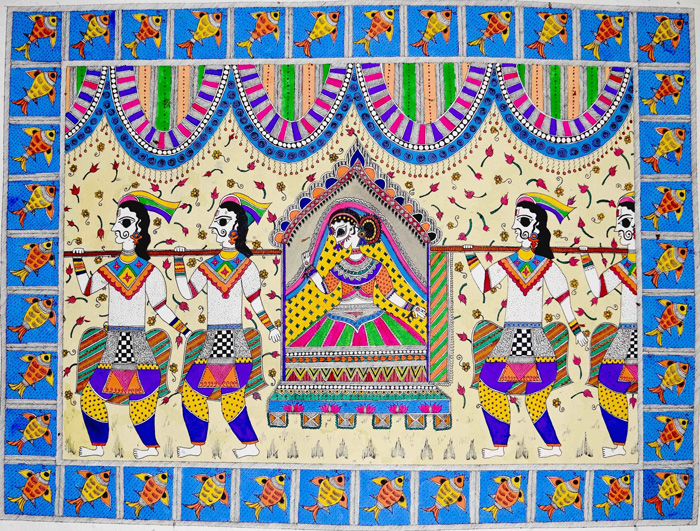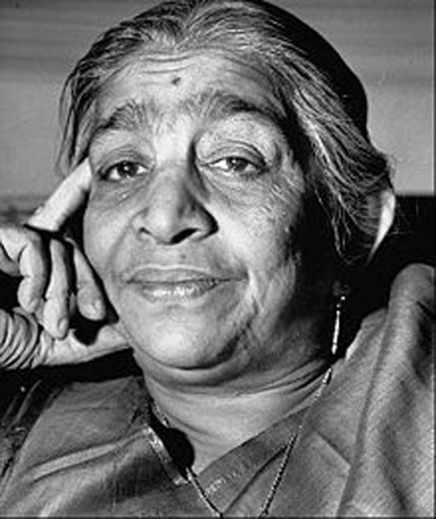About the poet:
Sarojini Naidu (whose maiden surname was Chattopadhyay) was an Indian independence activist and poet. She is also known as The Nightingale of India. Naidu served as the first governor of the United Provinces of Agra and Oudh between 1947 and 1949, and she was also the first woman to become the governor of an Indian state. She was elected as the second president of the Indian National Congress in 1925 and was also the first Indian woman to hold such a position.
Sarojini Naidu was born on 13 February 1879 in Hyderabad. Her father and mother were Aghore Nath Chattopadhyay and Barada Sundari Debi, respectively. Her father had received a doctorate of Science from Edinburgh University. He then settled in Hyderabad, where he founded and administered the Hyderabad College, which was later renamed the Nizam’s College. Her mother was also a poetess like her and used to write poetry in Bengali. She was the eldest among eight siblings. Her younger brother Virendranath was a revolutionary, and her other brother Harindranath was a poet, a dramatist, and an actor.
Naidu passed her matriculation examination from the University of Madras and then took four years’ break from her studies. In 1895, the “Nizam Scholarship Trust,” founded by the 6th Nizam named, Mir Mahbub Ali Khan, was granted to Naidu. As a result, she got the chance to study in England, first at King’s College London and later at Girton College, Cambridge.
At the age of 19, after finishing her studies, she got married to Govindarajulu Naidu, a doctor by profession. Inter-caste marriages were not allowed at the time, but her father approved the marriage. The couple had five children. Naidu’s daughter Padmaja later became the Governor of West Bengal.
Naidu joined the Indian national movement immediately after the partition of Bengal in 1905. Between 1915 and 1918, she traveled all over India and delivered lectures on social welfare, women’s empowerment, and nationalism. She also helped to establish the Women’s Indian Association (WIA) in 1917. She was even sent to London in the company of Annie Besant, President of WIA, to present the case for the women’s vote to the Joint Select Committee.
During the salt satyagraha of 1930, Naidu was among the women protesters at the Dharsana salt works in Gujarat. Hundreds of satyagrahis were beaten by soldiers under British command here. The ensuing publicity attracted world attention to the Indian independence movement and brought into question the legitimacy of British rule in India. In 1931, Naidu also participated in the Round table conference with Gandhi and Madan Mohan Malaviya. She played a leading role during the Civil Disobedience Movement and went to jail alongside the ranks of Gandhi and other leaders. In 1942, she was jailed again during the “Quit India” movement. She was also awarded the Kaiser-i-Hind Medal by the British government for her work during the plague epidemic in India.
Naidu began writing at the age of twelve. Her Persian play, Maher Muneer, is said to have greatly impressed the Nawab of Hyderabad. In 1905, her first collection of poems was published, and it was entitled “The Golden Threshold.” The collection entitled “The Feather of The Dawn” was edited and published posthumously in 1961 by her daughter Padmaja.
Sarojini Naidu died of a heart attack while working in her office in Lucknow on 2nd March 1949 and was mourned by the entire nation.
About In The Bazaars of Hyderabad:
“In The Bazaars of Hyderabad” is a 19th-century English poem by Sarojini Naidu. It was first published in the year 1912 in London as a part of Naidu’s collection of poetry entitled The Bird of Time.
Naidu here asks a series of questions about their goods to the merchants, vendors, pedlars, goldsmiths, fruit sellers, and flower girls in a traditional Hyderabadi market, all of whom similarly answer the questions of purchasers who buy their articles after detailed bargaining. The conversation form of the poem, which is set in the form of questions and answers between vendor and buyer, makes the readers feel that they are present in the bazaar.
Visual. Aural and olfactory imagery are all used here to enhance the reading experience.
The setting of In The Bazaars of Hyderabad:
As the title of the poem suggests, it is set in a market in the then princely state of Hyderabad in India.
Stanza-wise Summary of In The Bazaars of Hyderabad:
The poem consists of 5 stanzas. Each of these stanzas is again made up of 6 lines. Hence, the entire poem consists of 30 lines in total.
1st stanza:
What do you sell O ye merchants?
Richly your wares are displayed.
Turbans of crimson and silver,
Tunics of purple brocade,
Mirrors with panels of amber,
Daggers with handles of jade.
In this stanza, the poet asks the merchants what they are selling, for their goods are displayed in an elaborate manner, and her eye cannot take in all of them at once. However, she does notice red and silver turbans, purple tunics, mirrors set in frames made of amber, and knives with handles made of jade among them.
2nd stanza:
What do you weigh, O ye vendors?
Saffron and lentil and rice.
What do you grind, O ye maidens?
Sandalwood, henna, and spice.
What do you call, O ye pedlars?
Chessmen and ivory dice.
In this stanza, the poet asks vendors what sort of things they are weighing with their scales and suggests that they might be anything as rare as saffron or as common as lentils and rice. She also asks the young women whether they are making sandalwood paste, henna powder, or spices. She asks the pedlars what the names of things they are calling out for their customers to buy are. She can hear the names of chess pieces and die made out of ivory.
3rd stanza:
What do you make, O ye goldsmiths?
Wristlet and anklet and ring,
Bells for the feet of blue pigeons
Frail as a dragon-fly’s wing,
Girdles of gold for dancers,
Scabbards of gold for the king.
In this stanza, the poet asks the goldsmiths what ornaments they are making – whether for the wrists, the ankles, or the fingers. She can also see among their wares the bells that pigeons are made to wear that are as delicate as the wings of a dragonfly, the girdles worn on the slender waists of dancers, and the sheaths of gold that cover the swords of kings.
4th stanza:
What do you cry, O ye fruitmen?
Citron, pomegranate, and plum.
What do you play ,O musicians?
Cithar, sarangi and drum.
what do you chant, O magicians?
Spells for aeons to come.
In this stanza, the poet asks the fruit sellers whether they are calling out the names of citrons, pomegranates, or plums for their customers to buy. She also asks the musicians what their instruments are called, identifying the sitar, the sarangi, and the drum in the process. She asks the magicians what spells they are casting on the onlookers.
5th stanza:
What do you weave, O ye flower-girls
With tassels of azure and red?
Crowns for the brow of a bridegroom,
Chaplets to garland his bed.
Sheets of white blossoms new-garnered
To perfume the sleep of the dead.
In this stanza, the poet asks the flower girls what flowers they are using since they are blue and red in color, and she does not know their names. She only sees the forms that are created by the girls, such as the crown that goes on the head of a bridegroom at an Indian wedding or the garland that he will place around the neck of his wife. She also notices that white flowers have been used to weave a wreath that is placed upon the deceased at a funeral.
Updated by Anjali Roongta on 14th April 2023.
Some online learning platforms provide certifications, while others are designed to simply grow your skills in your personal and professional life. Including Masterclass and Coursera, here are our recommendations for the best online learning platforms you can sign up for today.
The 7 Best Online Learning Platforms of 2022
- Best Overall: Coursera
- Best for Niche Topics: Udemy
- Best for Creative Fields: Skillshare
- Best for Celebrity Lessons: MasterClass
- Best for STEM: EdX
- Best for Career Building: Udacity
- Best for Data Learning: Pluralsight















